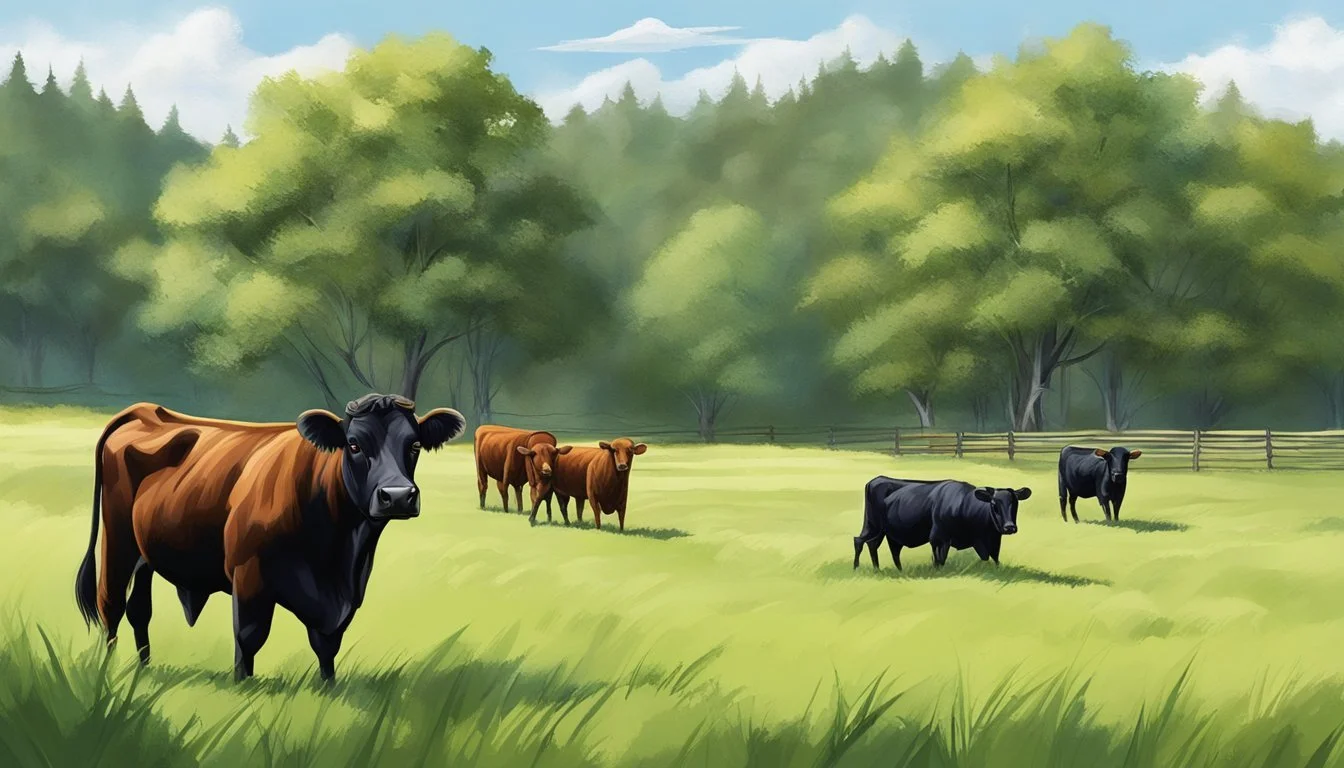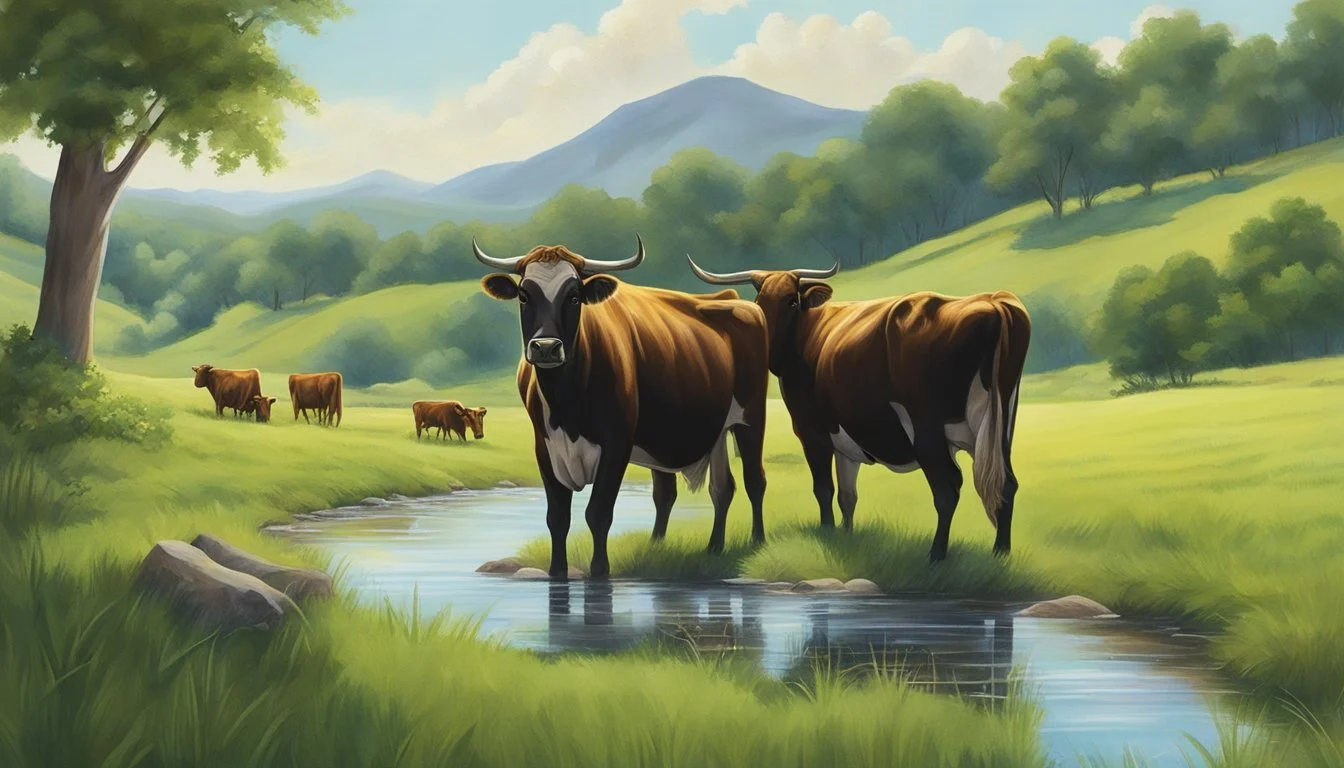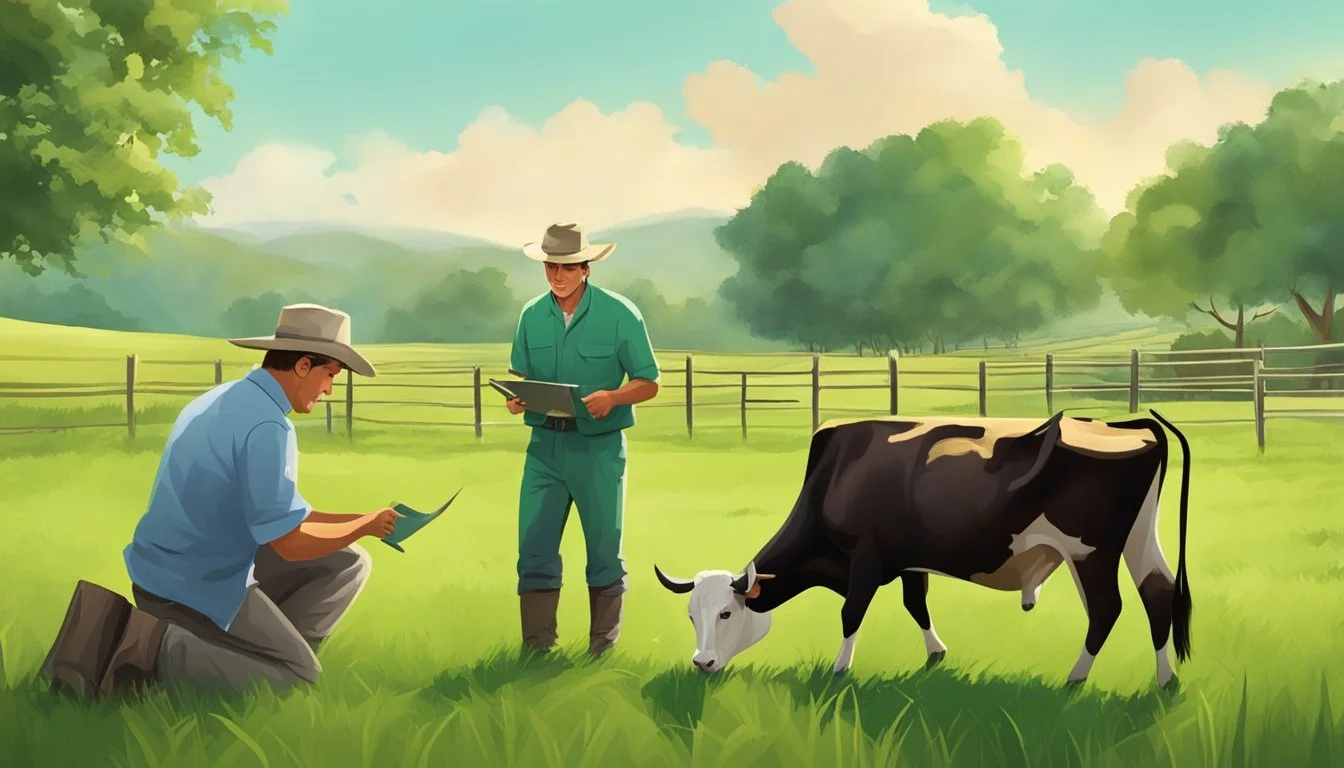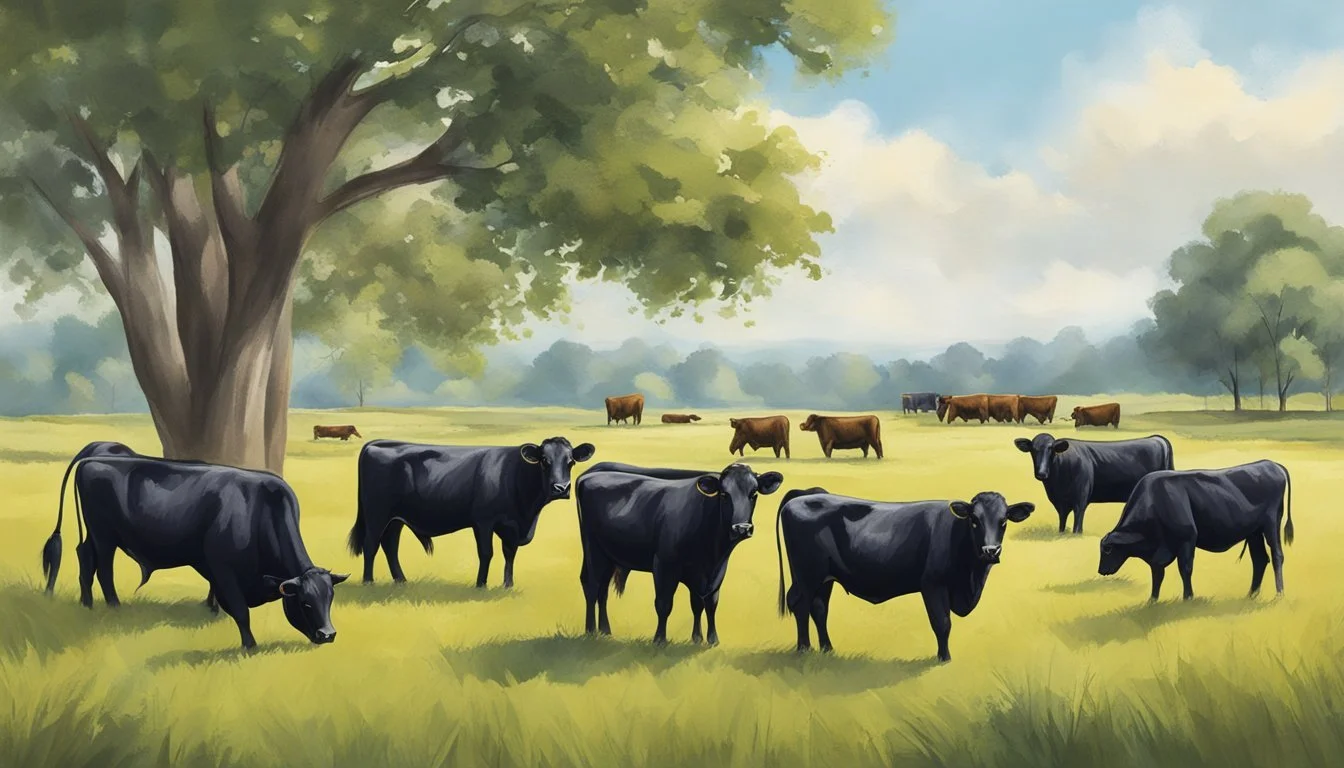Dexter Cattle Health 101
Managing Common Health Issues and Maximizing Well-being
Dexter cattle, a hardy and resilient breed, are increasingly favored by small-scale farmers and homesteading enthusiasts for their adaptability and dual-purpose utility. Despite their robustness, like all cattle breeds, Dexters are susceptible to common health issues. It is essential for owners to be able to identify and understand these problems in order to maintain the well-being of their herd. Familiarity with the symptoms, modes of transmission, and potential threats to Dexter cattle health is key in prevention and effective management.
An informed approach to health management includes the implementation of prevention strategies tailored specifically for Dexter cattle. Utilizing a combination of proper nutrition, regular vaccinations, and healthcare schedules, owners can significantly reduce the prevalence of diseases within their herds. Awareness and application of effective biosecurity measures further ensure that risks are minimized, contributing to the overall health of the cattle.
Understanding common health issues and prevention tips not only empowers owners to provide better care but it also contributes to the longevity and productivity of the herd. Frequent health monitoring, routine veterinarian checks, and a commitment to staying abreast of the latest health management practices are integral components of successful Dexter cattle rearing. By prioritizing health, owners support their cattle's ability to thrive in various climates and on diverse diets, whether pasture-based or supplemented with grain.
History and Origin of Dexter Cattle
Dexter cattle are a distinctive breed with deep roots in Ireland and a significant presence in America, known for their hardiness and size, which have influenced their historical roles.
Irish Roots and Expansion to America
Dexter cattle hail from Ireland, with origins traced back to the southwestern counties of Tipperary and Kerry in the early 1800s. They bear the name of a locale —Dexter's Ferry— near Cork's south coast. It’s believed that the breed may have been named after a man named Dexter, who was associated with Lord Hawarden’s estate on Valentia Island. This breed was initially cultivated by small landholders who needed versatile cattle suitable for both milk and meat production in their limited acreage. By the end of the 19th century, Dexters were recognized as distinct from the Kerry cattle breed.
Expansion to America occurred as breeders recognized the efficiency of these small-sized, hardy cattle. Dexter cattle were formally recorded in the English Kerry and Dexter Cattle Society Herd Book. The American Dexter Cattle Association now holds that historic role in the United States, promoting the breed and its development across the country.
Traits and Development of Dexter Cattle
Dexter cattle exhibit specific characteristics that have solidified their reputation:
Size: They are notably small, with some individuals being categorized as a dwarf breed due to chondrodysplasia.
Body shape: Dexters have a broad body with well-rounded hindquarters. They demonstrate adaptability, an essential trait for farming in diverse environments.
Color: Most commonly black, but shades of dun (pale brown) and red are also present among the breed.
Horn Status: Originally horned, selective breeding has led to a considerable number of naturally polled (hornless) Dexters.
As a result of these traits, Dexters have established themselves as a robust and adaptable breed capable of thriving in various climates and conditions, both in Ireland and the United States. Their development continues as they serve small scale farmers and hobbyists who value the breed’s economic and sustainable qualities.
Physical Characteristics
In considering physical attributes, Dexter cattle are notable for their small stature, which significantly influences their weight, as well as for their variety of coat colors.
Size and Weight Considerations
Dexter cattle are the smallest European cattle breed, making them a convenient choice for smaller farms. An adult Dexter bull typically weighs between 400 to 700 kilograms (900 to 1,550 pounds), while a cow usually weighs between 300 to 500 kilograms (700 to 1,100 pounds). Their height ranges from 36 to 44 inches at the shoulder for bulls, and 34 to 42 inches for cows, which is about half the size of a traditional Hereford.
Distinctive Coat Colors
The breed boasts a diverse palette of coat colors, typically categorized as black, red, and dun. The most commonly seen color is black, which varies from a true black to a more washed-out hue. The red varies from a light red to a deep rich red, similarly, dun ranges from a light wheat color to a darker, old gold shade. Some Dexters may possess white markings, often found on the udder or underbelly, which, while not as common, are considered standard.
Nutritional Needs and Feeding
Dexter cattle require a balanced diet fortified with essential nutrients to maintain their health and productivity. Adherence to best practices in feeding and grazing ensures these needs are met effectively.
Essential Nutrients for Dexter Cattle
Dexter cattle need a mix of proteins, carbohydrates, fats, vitamins, and minerals for optimal health. Proteins are crucial for growth and repair, while carbohydrates and fats provide energy. Vitamins and minerals, such as Vitamin A and calcium, support various bodily functions and bone health.
Proteins: Vital for muscle development and bodily functions.
Carbohydrates and Fats: Serve as primary energy sources.
Vitamins: Ensure proper metabolic processes.
Minerals: Essential for bone development and enzyme functions.
Best Practices in Feeding and Grazing
Feeding Dexter cattle involves a combination of pasture-based diets and supplemental feed when necessary. They should have access to quality pasture for grazing to fulfill their nutritional needs. When pasture quality is low, grain supplementation can provide the additional energy and nutrients required.
Pasture Grazing: Should be quality and plentiful for natural diet inclination.
Supplemental Feeding: Utilized when pasture alone is insufficient.
It's essential to avoid overfeeding and to monitor body condition to prevent obesity and associated health issues. Regular assessments of the condition and quality of the pasture, along with the cattle's health, can help in making informed decisions about their diet.
Reproductive Health
The reproductive health of Dexter cattle is critical to sustaining a productive farm. Optimal management of calving and the care of calves, along with the attention to the health of both bulls and heifers, is essential.
Calving and Calf Care
In Dexter cattle, calving can sometimes present challenges due to the breed's smaller stature. Vigilance is required during the calving period to swiftly identify and address any calving difficulties. Farmers should monitor for signs of labor and be prepared to assist if necessary. Following birth, calf care is paramount. Colostrum intake within the first few hours is critical for the calf's immunity. Calves should also be checked for congenital issues and receive routine health procedures, including tagging and vaccinations.
Calving Checklist:
Observation for labor signs
Assistance equipment readiness
Clean calving area
Calf Care Post-Birth:
Ensure colostrum intake within 6 hours
Perform health checks
Administer necessary vaccinations
Managing Dexter Bulls and Heifers
The management of Dexter bulls requires attention to both physical and behavioral health. Bulls must be kept in robust condition to ensure effective breeding. It is beneficial to conduct routine fertility evaluations and provide proper nutrition tailored to reproductive health. For heifers, pre-breeding health assessments are advisable to ensure they are fit for pregnancy and calving. Farmers should maintain accurate records of breeding activity and gestation length, with a standard expectation of a calf being born approximately 283 days post-conception.
Bull Management:
Regular fertility checks
Adequate feeding regimen
Monitor for health issues
Heifer Readiness:
Pre-breeding veterinary exams
Monitoring of breeding cycles
Nutrition tailored for reproduction
Common Health Issues
In managing the health of Dexter cattle, certain conditions are prevalent that require attention and action. By understanding these issues, preventive measures can be taken to maintain herd health.
Infectious Diseases and Prevention
Infectious Bovine Rhinotracheitis (IBR):
Cause: A highly contagious respiratory disease caused by Bovine Herpesvirus-1 (BHV-1).
Prevention: Regular vaccination; maintaining a closed herd; isolation of new or sick animals.
Foot Rot:
Cause: A bacterial infection typically introduced through wet, unsanitary conditions causing inflammation and lameness.
Prevention: Good pasture and barn management; prompt treatment of cuts; regular foot checks.
Non-Infectious Disorders and Care
Grass Tetany:
Cause: A magnesium deficiency often occurring when cattle graze on lush, fast-growing grasses.
Treatment: Administration of magnesium, either through injections or mineral supplements.
Prevention: Providing a magnesium-rich mineral supplement before and during risk periods.
General Care:
Ensuring access to clean water and a balanced diet.
Regular health check-ups and adherence to a vaccination schedule.
Environmental management to reduce stress and overcrowding.
Disease Prevention and Biosecurity
Effective disease prevention and biosecurity are fundamental in maintaining the health of Dexter cattle. Biosecurity entails precautionary measures designed to reduce the risk of disease transmission among livestock, and to and from humans. Producers must prioritize biosecurity to ensure the well-being of their herds.
Vaccine Protocols: Vaccines are a pivotal component of any prevention strategy. Dexter cattle should be immunized according to a schedule coordinated with a veterinarian. This routine not only protects the herd from common pathogens but also reduces potential outbreaks.
On-Farm Practices:
Quarantine new or returning animals before introducing them to the herd.
Implement a sanitation regime for people, equipment, and vehicles entering or exiting the farm.
Enforce pest control programs to minimize disease vectors.
Cattle Management: Stress can weaken immune systems, making cattle more susceptible to illness. Effective cattle management involves:
Providing balanced nutrition tailored to the herd's needs.
Ensuring clean water is always available.
Maintaining a comfortable environment with adequate space and shelter.
Education and Training: Farm personnel should be properly trained in recognizing early signs of disease, proper handling of livestock, and emergency protocols for disease outbreaks. Regularly updating training programs reflects the latest in biosecurity practices.
Staunch application of biosecurity measures and diligent cattle management practices are indispensable for disease prevention. Dexter cattle owners committed to rigorous prevention strategies can mitigate health risks and sustain their herds' productivity and well-being.
Management and Handling
Effective management and handling are crucial for maintaining the health and well-being of Dexter cattle. They require appropriate housing to protect them from weather extremes and handling techniques that minimize stress.
Housing and Shelter Needs
Dexter cattle need sturdy and well-ventilated housing that provides protection from extreme weather conditions. Adequate space is essential, allowing each animal to move freely and rest comfortably without competition for resources. Shelters should be designed to prevent dampness and should be regularly cleaned to prevent disease. An ideal shelter structure for Dexters might include:
Ample Space: Minimum of 1.5 to 2 square meters per animal.
Bedding: Dry, clean bedding to provide comfort and warmth.
Ventilation: Good airflow to minimize respiratory issues.
Behavior and Low-Stress Handling Techniques
Dexter cattle, like all livestock, respond better to low-stress handling techniques which are based on understanding their behavior. Handlers should always approach cattle calmly and with patience, using predictable movements to avoid startling the animals. Key practices in low-stress handling include:
Consistent Routine: Routine procedures help cattle anticipate human interactions.
Gentle Guidance: Use of pressure and release methods to move cattle willingly.
Training: Familiarizing the cattle with handling facilities before stressful procedures.
By focusing on the individual needs of Dexter cattle for shelter and implementing low-stress handling techniques, producers can ensure the health and productivity of their herd.
Utilization and Productivity
Dexter cattle are valued for their versatility as both beef and dairy producers. They often excel in small-scale operations where their dual-purpose nature is a significant advantage.
Dexter Cattle as Beef Producers
Dexter cattle are renowned for the high-quality, flavorful beef they produce. Meat quality is a standout attribute, with their cuts being well-marbled and tender. These cattle are smaller than many beef breeds, yet they efficiently convert feed into meat, making them a cost-effective option for beef production, especially on smaller farms.
Efficient Beef Production:
Smaller stature gene leads to lower feed costs.
Ideal for high-quality niche meat markets.
Dexter Cattle in Dairy Production
In the realm of dairy, Dexter cattle excel with milk that is rich in butterfat content, resulting in a creamy product well-suited for making cheese and other dairy products. Although their milk production may be lower than larger dairy breeds, the quality of milk is often higher, with a butterfat content that can range from 4% to 5%.
Premium Milk Quality:
High butterfat content (4-5%)
Ideal for artisanal cheese and butter production.
Roles Beyond Meat and Milk
Aside from their notable contributions to meat and milk markets, Dexters are also valued for their ability to thrive in a variety of climates and forage conditions, making them not just dual-purpose in terms of products, but also in the roles they can fulfill on a farm, from grazing to land management.
Additional Farm Roles:
Natural grazers that help in pasture maintenance.
Utilized in sustainable agriculture practices.
Breed Associations and Resources
This section provides insight into key organizations and informational support systems that are integral to maintaining the health and breeding standards of Dexter cattle.
American Dexter Cattle Association and Other Groups
The American Dexter Cattle Association (ADCA) is a pivotal resource for Dexter cattle owners, offering a wealth of information and programs aimed at the maintenance and improvement of the breed. It acts as a protective and promotional body that provides services designed to enhance the value of Dexter cattle. This association not only offers a registry service but also organizes events and shows, which helps to foster community and collaboration among breeders.
Other groups, both regional and international, also contribute to supporting Dexter cattle enthusiasts. These organizations often work in tandem with the ADCA to ensure consistent and accurate information is dispersed, and breed standards are upheld.
Educational Resources and Community Support
Within the ADCA and beyond, a myriad of educational resources are available, including:
Publications: Bulletins and guides that cover a broad range of topics from breeding to healthcare.
Workshops: Hands-on learning opportunities for breeders at all levels.
The Dexter cattle community is noted for its robust support system. Experienced breeders and associations provide invaluable guidance, often facilitating:
Networking opportunities: Connecting new and seasoned owners.
Forums and discussions: Platforms for sharing advice and discussing breed-specific concerns.
The community also works closely with veterinary experts to assemble healthcare schedules and recommendations that are tailored to the unique requirements of the Dexter breed. This collaborative environment ensures that breeders have access to current, reliable information to make informed decisions regarding the care and management of their cattle.








